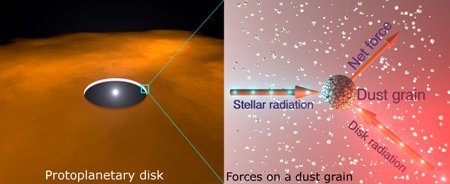Press Release
HRVATSKA VERZIJA: PDF
Embargoed Until 1800 London time / 1300 US Eastern Time on 13 May 2009
Surfing on the light of planet forming dust clouds
SPLIT, CROATIA, May 14, 2009 -
Rocky planets such as Earth are all believed to have begun as dust circling newly born stars. Ample evidence of this is found in today's meteorites and comets of the solar system, as well as observations of circumstellar disks around young stars. However, details of the evolution of dust and how it eventually comes to form larger objects such as comets and planets are still largely unexplained.
One of the key ingredients in planet and comet formation studies is to understand and account for all mechanisms that influence dust movements through the "protoplanetary disk" - the thick disk of dust and gas where planets and comets are forming. In a paper published in this week's Nature, Dejan Vinković, associate professor of astrophysics at the University of Split, Croatia, describes a new mechanism that moves particles in a previously unexpected way and has the ability to transport them over large distances.
The force produced by the light shining on an object is a well known phenomenon called radiation pressure. We do not feel it in daily lives because we are too massive for this effect to be noticeable. For very small particles, on the other hand, this force can be larger even than the gravity that keeps particles in the orbit around the star. Investigations have been focused so far only to the radiation pressure due to the starlight. The results showed that individual grains would not travel far and would be pushed deeper into the disk.

Combination of radiation pressure from the star and the disk creates a net force that enables dust grains to surf along the disk surface from inner to outer regions of the disk.
High resolution image: TIFF, JPG
Slike visoke rezolucije: TIFF, JPG
However, Vinković points out that it is not only the star, but also the disk that shines. When studying effects on protoplanetary dust grains larger than one micrometer, which is comparable to the particle size of cigarette smoke, Vinković has discovered that the intense infrared light from the hottest regions of the protoplanetary disk is capable of pushing such dust out of the disk. Infrared radiation is what we can feel as "heat" on our skin. Combination of radiation pressure from the star and the disk creates a net force that enables dust grains to surf along the disk surface from inner to outer regions of the disk.
The temperatures in this hot region reach around 1500 degrees Kelvin (2200 degrees Fahrenheit), enough to vaporize solid dust particles or to alter their physical and chemical structure. The mechanism that Vinković describes in his paper would transfer such altered dust particles to colder disk regions away form the star. This can explain why comets contain a puzzling combination of ices and particles altered at high temperatures. Astronomers have been perplexed by this mixture, since comets form in cold disk regions out of frozen substances like water, carbon dioxide or methane. Rocky dust particles that end up mixed with ices are therefore expected to never experience high temperatures.
This mechanism is also important for our understanding of the structure of the inner hot part of protoplantary disk, as well as in the interpretation of images and spectra of inner disks that astronomers detect around young stars. Theories aiming at reconstructing the planet formation process need a realistic description of the initial conditions and the disk structure. Vinković points out that his mechanism has to be taken into account because it helps with local mixing of dust grains in the inner disk.
Contact:
Dejan Vinković ( vinkovic _AT_ pmfst.hr )
Vinkovic, D. 2009, "Radiation-pressure mixing of large dust grains in protoplanetary disks", Nature 459, 227-229 (1
4 May 2009): ONLINE, PDF from arXiv.org
see also: News and views in Nature
Selected links of the press coverage:
ScienceNews, 13 May 2009
ScienceNOW, 14 May 2009
Novi list, 16 Svibnja 2009 (Ispravka krivog navoda u tekstu: tocan iznos je 100.000kn)
Jutarnji list, 21 Svibnja 2009
Medjimurske novine, 28 Srpnja 2009 (Ispravka kao i kod Novog lista)
|